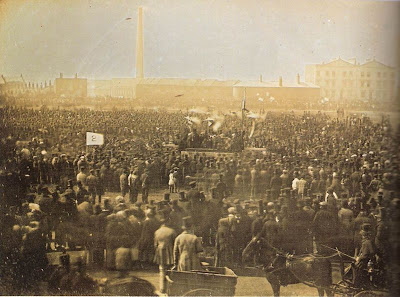作者-海華
一八七五年的日不落國大不列顛如日中天、欣欣向榮. 就在這麼個四海升平, 無大事可敍的一年, 倫敦西城區一對中產新婚夫婦帶著愉快的心情,搬進了肯辛頓區斯塔福排屋18號 (18 Strafford Terrace, Kensington). 男主人漫畫家Edward Linley Sambourne是個不起眼的小人物 -- 出身平凡, 樣子不帥, 甚至他的漫畫也並不驚天動地. 後人之所以到他家參觀, 純粹是為了親身感受一下維多利亞年代迅速堀起的中產階層生活.

Linley Sambourne House
Edward與太太Marion當年斥資2,000英鎊, 也就是今天的100萬英鎊(1,200萬港元), 在時尚住宅區買下了這棟阰鄰荷蘭公園連地下室共五層的排屋. 房價的一半由Marion的券商父親支付, 作為他們的結婚禮物. Strafford Terrace 18號不僅僅是他們的家, 也是Edward的工作室. 當時三十一歲的Edward替Punch雜誌劃插畫已八年之久,有穩定收入, 但算不上大富大貴.夫婦倆精打細算, 卻也很會過中上層的”小資”日子.
這跟Edward的工作很有關係 -- 由商人之子/劇作人Mark Lemon於1841年創辨 的Punch周刊以風趣幽默的筆觸諷刺時弊,迅速走紅中產階層, 後來讀者甚至包括維多利亞女皇與亞伯特親王(Prince Albert). Edward喜歡交朋結友, 二十四歲的太太出身中上層家庭, 妹妹們又嫁得很好, 夫妻倆都好客, 對於家裏的佈置致致不倦.
當時的貴族精英對這些”亳無品味”、滿身銅嗅的中產經常投以白眼. 不過伴隨著工業革命而來的是政治結構的調整. Edward第一次在Punch蹬場是1867年4月, 為下議會議員John Bright繪畫的政治”卡通”插畫.同年5月,二十萬民眾聚集海德公園要求普選, 政府想過用武力鎮壓, 終究英國人的冷靜發揮了作用沒釀成流血衝突*. 而且為了疏導民怨,政府速速通過人民代表法1867 (Representation of the People Act 1867),予以英國大部份城市男子居民投票權 -- 聽起了好像很動盪不安, 實際上, 女皇本人因為深愛的丈夫去逝已好幾年沒怎麼露面了, 而我們的男主角Edward正穩步邁向中上層生活. 十七年後, 人民代表法1884 (Representation of the People Act 1884)通過, 全國550萬名男子投票權(雖然女子仍未獲同等待遇 - 直至Representation of the People Act 1918).

The Great Chartist Meeting on Kennington Common, London in 1848. **
這其間, Edward的小日子過得美美 -- 早上騎馬到倫敦郊外走走.接下來開始作畫.下午則到不同的會所與作家、政客、演員、商人、律師等碰頭聚會. 太太Marion管理家裏兩個女傭、廚子、馬夫.她也有自已的生活 -- 早上到離家五分鐘的商業街逛逛, 午飯後打電話與朋友噓寒問暖一番, 每周二必定在家款待友人亨用下午茶. 晚上要麼去看戲, 要麼在家裏招呼客人.
擁有五千年歷史的中國呢? 一八七五年, 大清光緒帝剛剛登基, 這時鴉片戰爭已結束十五年了.年輕的皇帝也想變法圖強, 可在中國沒有滋養中產階產的土壤. 等著愛新覺羅載湉的是中法戰爭、是甲午海戰、是馬關條約. 朝政腐朽已入膏肓, 離整個皇朝的覆滅也就不到四十年了.

A Punch cartoon from August 1867 portraying the bill as a leap in the dark
* Great Demonstration in May 1867 at Hyde Park -- "The Reform League, agitating for universal suffrage, became much more active and organized demonstrations of hundreds of thousands of people in Manchester, Glasgow and other towns. Though these movements did not normally use revolutionary language like some Chartists had in the 1840s, they were powerful movements. The high point came when a demonstration in May 1867 in Hyde Park was banned by the government. Thousands of troops and policemen were prepared, but the crowds were so huge that the government did not dare to attack. The Home Secretary, Spencer Walpole, was forced to resign."
** People's Charter of 1838 , which stipulated the six main aims of the movement as:
1) A vote for every man twenty-one years of age, of sound mind, and not undergoing punishment for crime.
2) The ballot. - To protect the elector in the exercise of his vote.
3) No property qualification for members of Parliament - thus enabling the constituencies to return the man of their choice, be he rich or poor.
4) Payment of members, thus enabling an honest tradesman, working man, or other person, to serve a constituency, when taken from his business to attend to the interests of the Country.
5) Equal Constituencies, securing the same amount of representation for the same number of electors, instead of allowing small constituencies to swamp the votes of large ones.
6) Annual parliaments, thus presenting the most effectual check to bribery and intimidation, since though a constituency might be bought once in seven years (even with the ballot), no purse could buy a constituency (under a system of universal suffrage) in each ensuing twelve-month; and since members, when elected for a year only, would not be able to defy and betray their constituents as now.
伸延閱讀:
(1) "The Victorians" by Jeremy Paxman, BBC documentary
(2) A short summary of Victorian Industrialization - "A History of Britain" - by Simon Schama, BBC documentary
(3) "A History of Britain" - Episode 13 "Victoria and her Sisters" by Simon Schama, BBC documentary [part 1], [part 2], [part 3], [part 4], [part 5], [part 6], [part 7]


